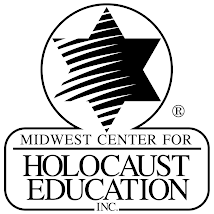I feel like I should begin this blog entry with a couple of disclaimers. First, this year I am teaching several sections of 7
th and 8
th grade Creative Writing; it is an elective class. I did not imagine that I could find a way to teach the Holocaust in Creative Writing. Second, as a Holocaust educator, I have a fairly strong prejudice against fictional Holocaust literature. I believe there are excellent memoirs, diaries, and non-fiction pieces which students can read to understand the personal experiences of those who survived or perished during the Holocaust.
 That being said, I came upon an interesting book recently which I offer for your consideration. Requiem: Poems of the Terezín Ghetto by Paul B. Janeczko. The poems in the volume were written by Janeczko; however, the voices of the poems vary and show us the Terezín Ghetto from various points-of-view. For example, Hilda Bartos tells us, in her poem, how Terezín changed once the town began to be used as a prison for Jews. SS Lieutenant Theodor Lang speaks in his poem of preparations for a visit by the Red Cross. In most of the poems, we hear the imagined voices of Jews imprisoned at Terezín. Tomasz Kassewitz tells, in his poem, about playing chess on Fridays with his friend Willi - until it becomes too dangerous for Willi to socialize with a Jew. Trude Reimer tells of playing the part of a cat in the play Brundibár. Sara Engel tells of her experiences sorting the possessions confiscated from the ghetto’s prisoners. The volume is illustrated with drawings created by inmates of Terezín which were discovered after the war ended.
That being said, I came upon an interesting book recently which I offer for your consideration. Requiem: Poems of the Terezín Ghetto by Paul B. Janeczko. The poems in the volume were written by Janeczko; however, the voices of the poems vary and show us the Terezín Ghetto from various points-of-view. For example, Hilda Bartos tells us, in her poem, how Terezín changed once the town began to be used as a prison for Jews. SS Lieutenant Theodor Lang speaks in his poem of preparations for a visit by the Red Cross. In most of the poems, we hear the imagined voices of Jews imprisoned at Terezín. Tomasz Kassewitz tells, in his poem, about playing chess on Fridays with his friend Willi - until it becomes too dangerous for Willi to socialize with a Jew. Trude Reimer tells of playing the part of a cat in the play Brundibár. Sara Engel tells of her experiences sorting the possessions confiscated from the ghetto’s prisoners. The volume is illustrated with drawings created by inmates of Terezín which were discovered after the war ended.
The poems reflect solid research by Janeczko. The Afterword and Author’s Note at the back of the volume provide valuable background information that I would advise reading first. There is an excellent list of sources at the end of the text.
In my view, there are at least two questions worthy of debate concerning Janeczko’s work. First, does this volume of poetry contribute in a significant and valuable way to the canon of Holocaust literature? Second, would Requiem serve as a useful instructional tool with secondary students?
I don’t think I qualify as an expert, but I have read quite a lot of Holocaust literature during the past ten years. I own cabinets full of memoirs, diaries, short stories, novels, and non-fiction history. I can think of some individual poems that I have read about Holocaust topics. However, I can’t recall anyone who has tried to do what Janeczko has done – create a single portrait of a ghetto from the points-of-view of the inmates, Nazi guards, and non-Jewish residents of the nearby town. Original poems from all of these perspectives do not, to my knowledge, exist within the historical record. Therefore, Janeczko had no choice but to create them from his imagination based on extensive research. To answer the first question – yes, I think this volume does make a valuable and interesting addition to the canon of Holocaust literature.
My answer to the second question is also yes. The poems in this volume are excellent examples of free verse poetry and could be used as models in several of the craft lessons I teach in Creative Writing. The book is a lovely example of how poems can be used to create a narrative; in this case they tell the story of people whose lives converged in a particular place but not by chance. The book would be an excellent source of material for students in performance, drama, or forensics courses. How exciting it would be to see a group of students perform an interpretive reading of the poems in this volume! The book is very short – only 89 pages of poems and illustrations. Therefore, this may be a good choice for time-strapped language arts or social studies teachers who want to complement non-fiction Holocaust materials with materials from the fine arts. Art teachers may enjoy studying the illustrations that were created by Terezín’s residents. I stated in my first disclaimer that I had not considered teaching the Holocaust in Creative Writing. I think Janeczko's poems create that possibility.
I happened upon Requiem: Poems of the Terezín Ghetto by Paul B. Janeczko by accident. I was searching the Johnson County Library for poetry books for use in my Creative Writing classes. However, I think I stumbled over a gem. I am curious for other Holocaust educators to read this book and share what they think about it.



